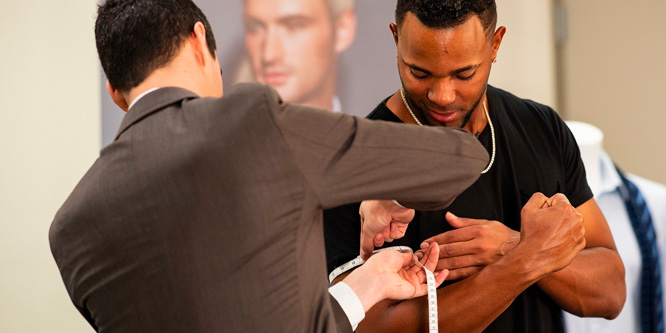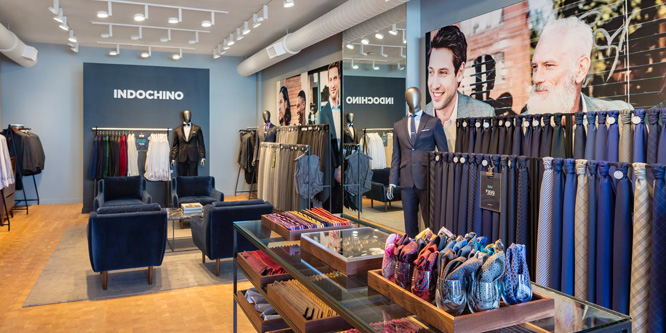
Photo: Indochino
Indochino bets big on showrooms
At last week’s Future Stores Seattle conference, attendees heard quite a lot from digitally-native retailers about making the journey offline through experiential showrooms.
While this approach receives some skepticism as a sales channel, Drew Green, president and CEO of men’s custom garment retailer Indochino, pushed back against this view by crediting the brand’s seven-times growth trajectory to the introduction of showrooms alone.
Customers can book a one-hour appointment online for one of Indochino’s 45 showrooms and work with an expert to help pick out their very own custom suit, down to the color and fabric. With 50 percent of their transactions being repeat customers, Indochino’s commitment to customization seems to be working.
“Retail is our number one customer acquisition channel,” said Mr. Green. “When we introduce the brand [to our customers] through retail, we see a higher LTV and lower acquisition cost. Our costs were $145 to acquire a customer online and with retail it is $70.”

Given Indochino’s made-to-order business model and highly personalized retail experience, showrooms can reach profitability a lot faster than other brands because customers aren’t there to just browse but receive a service that when completed results in a $500 sale. With no inventory in stock and a 10 percent no show rate, Indochino is cash positive the moment someone shows up at its stores.
When asked about the future of Indochino, Mr. Green said, “We wanted to be the best at one thing, and that started with a suit. Now we’re endeavoring to be a custom apparel company. We believe the future is custom, being able to personalize any garment.”
It appears there may be a lot more showrooms in Indochino’s future.
Discussion Questions
DISCUSSION QUESTIONS: Are showrooms only viable for made-to-order retailers? How can a retailer commit to an exceptional personalized experience and remain profitable?


Can’t make a sweeping prediction, but I can comment on how utterly delightful their staff was in their Chicago store. I did what we all do — “Hi, I’m a retail geek, do you mind if I take photos of your displays?” — and struck up conversations with their team. They were so knowledgable about the production process and their competition, and were genuinely happy to be there. Something about their showrooms works, and if I had to bet, I’d guess it’s that they hire carefully and train well!
Kudos to Indochino for being smart and developing a winning program. However, look one step further, and what we really are seeing is well trained, personable, and knowledgeable store associates able to “wow” the customer. This service is what every retail store has the opportunity to provide, and when they do, they win big.
Indochino has a great product and can certainly satisfy the customer with their quality, design, and now service. It doesn’t take a rocket scientist to understand that with all the technology out there, there is no replacement for human interaction, and when done correctly, as Indochino is doing, it’s a big win for everyone. Why other retailers can’t see that I’ll never know!
Exceptionally personalized service can be delivered as long as a brand’s sales support it. Very different for a brand that averages $500 per sale versus $50.
Showrooming is sounding smarter and smarter to me. The decision to carry inventory is a decision to start guessing. Building a brand around “custom” and then straying into ‘guessing’ would be some sort of oxymoron. Expanding into other custom categories versus carrying inventory in existing categories sounds smart. Custom is the brand promise. Keep it. Showroom on, Indochino. Yer killin’ it.
This is not really “showrooming,” this is where you actually have your measurements taken and then a garment is produced. It used to be called a tailor shop.
Pretty sure that Indochino doesn’t think of themselves as a simple tailor shop of yesteryear. Pretty sure the customer agrees they aren’t a simple tailor shop.
We need to define what we mean by showrooms. As the distinction between online and brick & mortar shopping is increasingly blurred, a brand’s website is often a showroom for the store, and vice versa. This is why so many so-called digitally-native brands are opening physical locations, whether they are made-to-order or not.
So the answer to the question is no, of course not.
The adage that “there is nothing new under the sun” is reborn, as is the sartorial model to which Indochino evolved. The company was born as a pure-pay internet retailer in which the customer took his own measurements and the garment was subsequently produced and shipped. The model is now, come into our showrooms (the tailor) and we’ll make it for you. That is not new but it’s better and there are far fewer returns and repairs. Taylor, Schneider, Sastre, Sârtre, they are all the same and been around for centuries. But they work, so they keep coming back.
The thing that sets any in-store experience apart almost always comes down to people. The Indochino experience is highly personalized, exactly what I would expect to find from a bespoke retailer. Anything less would be unacceptable.
How can a retailer commit to an exceptional personalized experience and remain profitable? How can they not? Most of the things sold today are commodities; how they are sold is what sets them apart. This requires training and standards and hiring the right people. And making customer service an everyday priority.
I wish I had read this earlier so that I could have talked about how the quality of the service needs to meet or exceed the quality of the product.
I have yet to figure out why every retailer in the country, no matter what the price point, has not figured out that the most important decision that a manager makes is who is allowed in the door to take care of the customer and how that person is trained.
I tried the Indochino experience last year and found it to be lacking. While the showroom staff was polite and friendly, the process end to end took a long time and required a lot of rework. The fitting appointment itself takes close to an hour, my suit then arrived weeks later than it was promised and despite the exhaustive measurements taken the suit did not fit. The alterations to fix the fit issues took several more weeks. I’ve had a much quicker and more seamless experience buying at Nordstrom and working with their in house tailors for alterations.
I had a similar experience with a “personalized” shirt from Stannt that does not fit as well as a typical shirt bought off the rack.
Bottom line: apparel is hard and the showroom companies struggle to deliver on their promise of a perfect, custom fit.
This isn’t really showrooming because they are doing tailoring measurement. Really, this is a customer onboarding site because most people don’t know their measurements and don’t know how to do it correctly. By getting the measurements accurately and then showing the fabric options, it appeals to the bespoken nature of today’s customer. I do wonder how many times the employees have to deal with the “John Wick” tailoring request look though, LOL!
Showrooms just add to the theater of retail. This is just another arrow in the quiver. Pure play retailers need to move to an online presence … just look at what Amazon is doing and the whole floor at Hudson Yards dedicated to pure play pop-ups. Stores are morphing into showrooms and distribution centers. It’s simply evolution. Customers want to be treated like royalty and have personalized service, even when there is no person around and that is the secret to profitability. Retail is changing. Get ready for the ride.
There is one major benefit a brick and mortar store can do that a retail store cannot (at least, not yet!). It is the element of customization and personalization and that cannot be done without human interaction (again, for now, until AR technology hits the mainstream).
For men’s suits, one of the highest ranked value driver will always be fit. That’s why there has been a rise of men’s suiting brands that follow a similar business model — Suitsupply being the closest and potentially something like Bonobos close behind. That’s how you get someone into the store. How you keep them coming back is through your excellent customer service and constant refresh of product line.